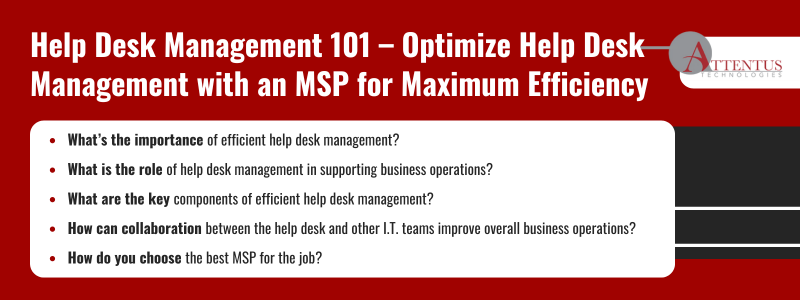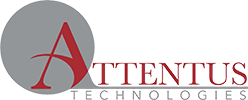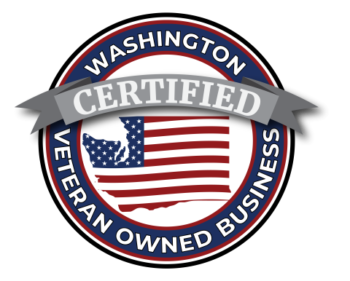Great help desk management informs overall I.T. strategy for business success

Efficient help desk management is crucial to maintaining smooth business operations, particularly in today’s fast-paced digital environment, where I.T. services are foundational to virtually all sectors. An effective help desk significantly enhances I.T. support and overall business productivity by ensuring that technical issues are resolved promptly and users’ needs are adequately met.
In this article, we’ll explore the role of help desk management in supporting overall business operations, the key components of an efficient help desk operation, best practices for the best support, efficiency tips, and how to integrate a help desk with a broader I.T. strategy. We’ll also discuss how the right managed service provider (MSP) is the true road to efficiency and how to find the best.
Understanding Help Desk Management
Help desk management is a crucial component of I.T. services and business operations. But what is help desk management? It’s the processes and practices involved in overseeing a help/service desk designed to support end-users with I.T.-related issues and questions.
The help desk is focused on immediate, user-facing technical support and addressing day-to-day operational issues like password resets and malfunctioning software and hardware. The goal is quick resolution and user satisfaction.
Their purpose is to ensure that:
- Users receive timely assistance and solutions for their problems.
- All incidents are logged, tracked, and resolved systematically to maintain a detailed history.
- A knowledge base of solutions and best practices is created and modified over time to enhance service quality and response times.
- Service level agreements are adhered to.
While help desk services and I.T. strategy services fall within the broader I.T. department, they have different roles. I.T. strategy concentrates on the long-term vision and the architecture of the organization. The strategic role involves:
- Planning and implementing projects related to system upgrades and infrastructure changes and improvements.
- Alignment of I.T. initiatives with overall business goals to drive innovation and efficiency.
- I.T. management roles that influence technology direction, budget allocation, and strategic partnerships.
In short, while help desk management is essential for immediate user support and operational efficiency, broader I.T. strategy services shape the organization’s technology landscape. Both functions are vital, and their successful collaboration is key to achieving comprehensive business goals.
Key Components of Help Desk Management
Effective help desk management is crucial for providing excellent customer support and maintaining high levels of user satisfaction. The key components include:
Ticketing systems
A ticketing system captures all customer interactions in one place. This ensures nothing is missed and that progress can be easily tracked. Tickets are categorized based on urgency and type so workloads can be prioritized effectively. A ticketing system lets users and support staff track ticket status, fostering trust and accountability.
Workflow automation
Workflow automation can direct tickets to the right department or technician based on predefined rules, speeding up response times. Automated escalation ensures that critical issues receive immediate attention if they are not resolved within a certain time frame. Automation can also set reminders for support agents to follow up, ensuring proactive communication.
The importance of response time
No one likes to wait for an I.T. problem to be solved, so response time is critically important to an efficient help desk. Quick response rates often lead to faster resolution—an effective help desk aims for a high first-contact resolution rate. Monitoring response times is essential to identify bottlenecks in the support process so necessary adjustments can be made.
Issue resolution
Effective help desk management involves understanding the underlying issues leading to repeated problems, allowing teams to address and eliminate them. By leveraging a knowledge base, support agents can quickly find solutions and guide users through common issues, promoting efficiency. Gathering feedback after resolution provides valuable insights into user experiences and potential areas for improvement.
Support Desk Best Practices
When establishing a support desk, following best practices is pivotal for efficient operations and exceptional customer service. Help desk efficiency tips include:
- Set a support workflow: Define stages from ticket submission to follow-up.
- Categorize and prioritize: Use a system and matrix for impact and urgency.
- Create escalation paths: Outline procedures, responsibilities, and response times.
- Standardize solutions: Develop SOPs for common issues.
- Build a knowledge base: Organize with categories and a search function.
Monitoring and metrics
Soliciting feedback from users about the support process and knowledge base content is an essential KPI (key performance indicator). Use surveys to gauge how well the help desk meets needs.
Other KPIs to pay attention to are the average response time, resolution time, and ticket backlog. Conduct support team meetings regularly to review performance and discuss solutions for persistent challenges. Monitoring and metrics will create an efficient, user-friendly support desk that empowers your team. Flexibility and adaptability are the keys to refining processes.
Integrate the Help Desk with Your Broader I.T. Strategy
Integrating help desk services with your organization’s broader I.T. strategy is essential to achieving business objectives while ensuring efficiency and quality in service delivery. Here’s how help desks can align effectively with overall business goals:
- Customer satisfaction: Help desks are often users’ first point of contact. Ensuring high levels of support not only resolves issues but also contributes to their satisfaction – and happy employees are productive employees.
- Operational efficiency: By resolving technical issues swiftly, the help desk minimizes downtime to maintain productivity and support overall business goals.
- Feedback loop: Help desks gather data on common issues and user feedback, which can be instrumental for the organization in identifying areas for improvement and innovation.
- Training and resources: Help desks can assist in training employees on new software and policies, aligning staff capabilities with the organization’s evolving business goals.
- Performance metrics: Use metrics that link help desk performance to business outcomes, reinforcing the value of their work beyond immediate technical support.
Encourage Collaboration for Better Technology Decisions
Collaboration between the help desk and I.T. teams is crucial for a smooth technology infrastructure and strategic decision-making. Establish regular meetings and use tools like Slack or Microsoft Teams to facilitate communication. Key strategies include:
- Shared Knowledge Base: Provide access to a common repository to streamline issue resolution.
- Cross-Team Engagement: Have I.T. strategy team members work with the help desk to understand user issues.
- Feedback Loops: Allow help desk staff to provide input on recurring problems to guide I.T. decisions.
- Analyze Help Desk Data: Use ticket data to identify common issues and inform I.T. priorities.
- User Satisfaction Surveys: Collect feedback to refine I.T. strategies based on user needs.
- Pilot Testing: Test new technologies with help desk teams for feedback before wider implementation.
- Continuous Improvement: Use help desk insights to address recurring issues and improve efficiency.
By fostering seamless communication and leveraging the help desk’s insights, organizations can create I.T. strategies that are more responsive to user needs, ultimately enhancing overall efficiency and satisfaction.
How to choose the right MSP
You might consider building your help desk from scratch, but that path is filled with challenges, and if you already have a help desk with performance issues, turning that around may be impossible. This is where an MSP can prove invaluable. In addition to help desk services, the best offer virtual chief information officer services that focus on your overall technology needs, including budgeting and strategy.
Choosing the right Managed Service Provider (MSP) is crucial for the success and efficiency of your I.T. operations. Look for:
- Experience and reputation: Look for an MSP with a proven track record in your industry. Check for certifications, client reviews, and testimonials.
- Customization: The MSP should provide tailored solutions that meet your unique business needs rather than a one-size-fits-all approach.
- Scalability: Choose an MSP that can grow with your business and easily scale its services as your needs change.
- Proactive monitoring and support: Look for an MSP that provides continuous monitoring of your systems to identify and resolve issues before they become significant problems.
- Communication and transparency: Effective communication is vital. Ensure they offer regular updates, reports, and easy access to support teams.
Also, consider the pricing model—flat fee or tiered—and watch for extra fees like onboarding or support not covered in the SLA. Evaluate value vs. cost; staying within budget is important, but don’t compromise on quality. Choosing an MSP is about more than technical skills; find a partner aligned with your business goals. Do thorough research and choose carefully.
When you want the best, choose Attentus Technologies
Attentus has a mission, and we live it every day. We focus on education for both your users and our technicians. We provide personalized service that builds long-term relationships. And we make I.T. simple. We listen to you and your users to develop clear and concrete strategies and solutions that work.
Communication is at the heart of everything we do, so reach out today or book a meeting by clicking the button on the home page and discover the Attentus difference: I.T. that works for you.
Attentus has a mission, and we live it every day. We focus on education for both your users and our technicians, providing personalized service that builds long-term relationships. With a 10-year average client retention rate, we’ve consistently earned trust and satisfaction by delivering I.T. solutions that simplify your operations.
With Attentus, you can count on swift, effective I.T. support, boasting 20-minute response times and intelligent, straightforward answers. Communication is at the heart of everything we do, ensuring you always receive reliable, responsive service. Reach out today or book a meeting by clicking the button on the home page, and discover the Attentus difference: I.T. that works for you.

